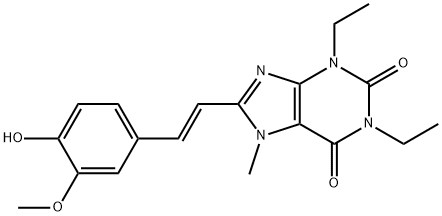Caffeic acid , 99% , 331-39-5
Synonym(s):
Caffeic acid;3,4-Dihydroxycinnamic acid;3-(3,4-Dihydroxyphenyl)-2-propenoic acid;3,4-Dihydroxybenzeneacrylic acid;trans-3,4-Dihydroxycinnamic acid
CAS NO.:331-39-5
Empirical Formula: C9H8O4
Molecular Weight: 180.16
MDL number: MFCD00004392
EINECS: 206-361-2
| Pack Size | Price | Stock | Quantity |
| 1g | RMB36.00 | In Stock |
|
| 5G | RMB112.80 | In Stock |
|
| 25G | RMB407.20 | In Stock |
|
| 100g | RMB1206.40 | In Stock |
|
| others | Enquire |
PRODUCT Properties
| Melting point: | 211-213 °C (dec.) (lit.) |
| Boiling point: | 272.96°C (rough estimate) |
| Density | 1.2933 (rough estimate) |
| refractive index | 1.4500 (estimate) |
| storage temp. | 2-8°C |
| solubility | ethanol: 50 mg/mL |
| form | powder |
| pka | 4.58±0.10(Predicted) |
| color | yellow to tan |
| Water Solubility | soluble in hot water |
| Merck | 14,1635 |
| BRN | 2210883 |
| Stability: | Stable. Combustible. Incompatible with strong oxidizing agents, strong bases. |
| InChIKey | QAIPRVGONGVQAS-DUXPYHPUSA-N |
| LogP | 1.150 |
| CAS DataBase Reference | 331-39-5(CAS DataBase Reference) |
| IARC | 2B (Vol. 56) 1993 |
| NIST Chemistry Reference | Cinnamic acid, 3,4-dihydroxy-(331-39-5) |
| EPA Substance Registry System | 2-Propenoic acid, 3-(3,4-dihydroxyphenyl)- (331-39-5) |
Description and Uses
Caffeic acid is abundant in the whole plant of Solidago decurrens Lour. (Yi Zhi
Huang Hua), fruit of Crataegus pinnatifida Bge. var. major N.E.Br. (Shan Li
Hong), Salix myrtillacea Anderss. (Po Liu), rhizome of Cimicifuga foetida L., rhizome of Polypodiaceae Polypodium vulgare L. (Ou Ya Shui Long Gu), peel of
Rutaceae Citrus limonum (Ning Meng), the whole plant of Polygonaceae Polygonum
aviculare L. (Pian Xu), root of Valeriana officinalis L. (Xie Cao), the whole plant of
Thymus mongolicus Ronn (She Xiang), leaves of Eucommia ulmoides (Du Zhong),
and other herbal plants. It is a kind of polyhydroxy styrene acid, with the general
chemical properties of phenolic acid. It is easily oxidized for the reason of the unsaturated double bonds, particularly unstable in alkaline solution
Caffeic acid has both cis and trans isomers, and the two isomers of caffeic acid
have a mutual transformation in plants, which may regulate some important physiological process. Caffeic acid exists in plants in the main form of complexes; free
state accounts for a few proportion.
antineoplastic, PGE2 synthase inhibitor, PK inhibitor
Safety
| Symbol(GHS) |  GHS08 |
| Signal word | Warning |
| Hazard statements | H351 |
| Precautionary statements | P280 |
| Hazard Codes | Xn,Xi |
| Risk Statements | 36/37/38-40-63-68 |
| Safety Statements | 26-36/37/39-36 |
| WGK Germany | 3 |
| RTECS | GD8950000 |
| Hazard Note | Irritant |
| HS Code | 29182990 |
| Hazardous Substances Data | 331-39-5(Hazardous Substances Data) |






